Financial Accounting Report: Principles, Applications, and Analysis
VerifiedAdded on 2020/10/05
|36
|5995
|284
Report
AI Summary
This comprehensive financial accounting report delves into the core principles and practices of financial accounting. It begins by defining financial accounting and exploring its regulatory framework, including GAAP and IFRS. The report then examines key accounting principles such as the business entity, money measurement, dual aspect, going concern, cost, accounting year, matching, and realization principles. It also covers accounting conventions like consistency and material disclosure. The report includes practical examples, such as the methods of depreciation and the importance of bank reconciliation statements, and control accounts. The report also discusses the concepts of consistency and prudence, and provides detailed explanations of the straight-line and diminishing balance methods of depreciation. This report aims to provide a thorough understanding of financial accounting for students.

FINANCIAL ACCOUNTING
PRINCIPLES
PRINCIPLES
Paraphrase This Document
Need a fresh take? Get an instant paraphrase of this document with our AI Paraphraser
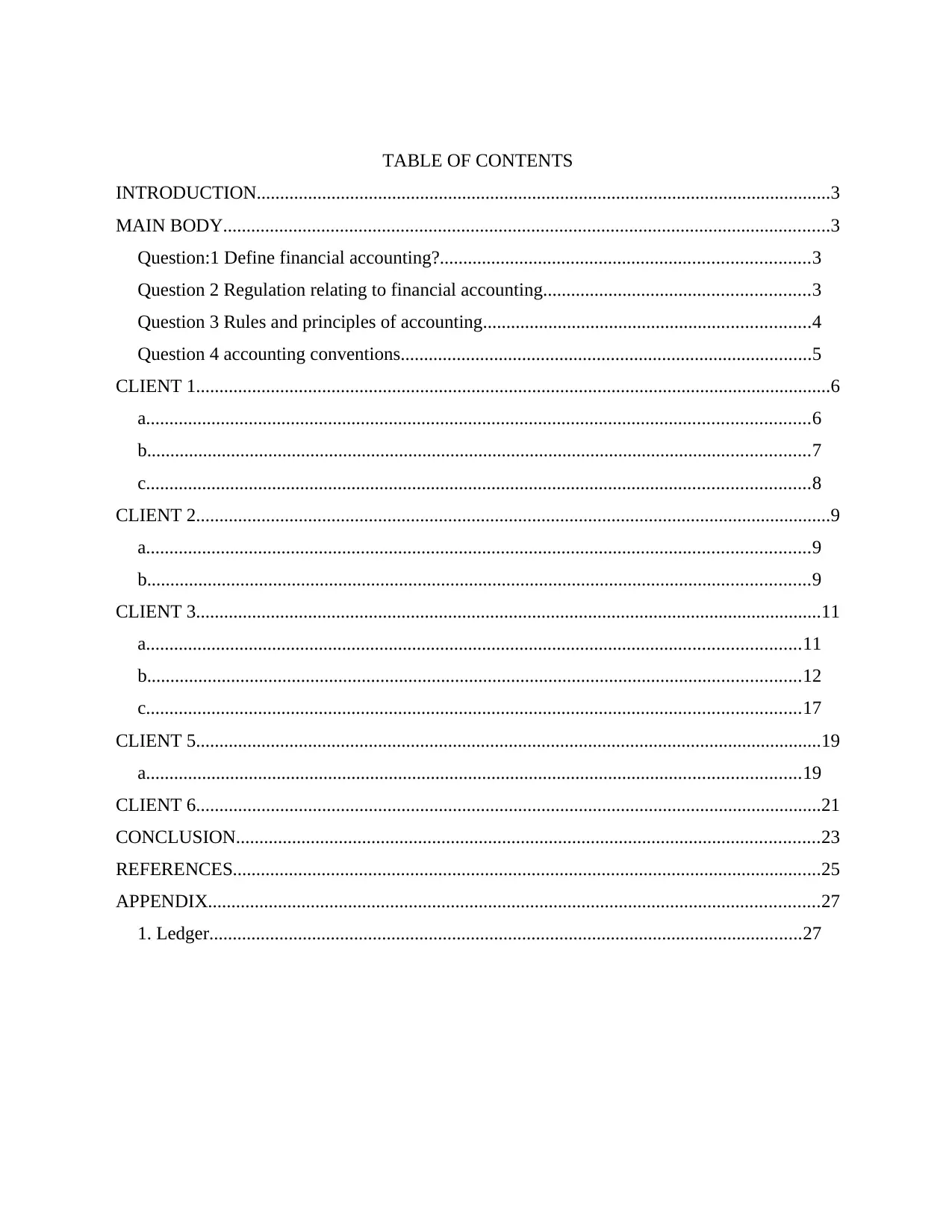
TABLE OF CONTENTS
INTRODUCTION...........................................................................................................................3
MAIN BODY..................................................................................................................................3
Question:1 Define financial accounting?...............................................................................3
Question 2 Regulation relating to financial accounting.........................................................3
Question 3 Rules and principles of accounting......................................................................4
Question 4 accounting conventions........................................................................................5
CLIENT 1........................................................................................................................................6
a..............................................................................................................................................6
b..............................................................................................................................................7
c..............................................................................................................................................8
CLIENT 2........................................................................................................................................9
a..............................................................................................................................................9
b..............................................................................................................................................9
CLIENT 3......................................................................................................................................11
a............................................................................................................................................11
b............................................................................................................................................12
c............................................................................................................................................17
CLIENT 5......................................................................................................................................19
a............................................................................................................................................19
CLIENT 6......................................................................................................................................21
CONCLUSION.............................................................................................................................23
REFERENCES..............................................................................................................................25
APPENDIX...................................................................................................................................27
1. Ledger...............................................................................................................................27
INTRODUCTION...........................................................................................................................3
MAIN BODY..................................................................................................................................3
Question:1 Define financial accounting?...............................................................................3
Question 2 Regulation relating to financial accounting.........................................................3
Question 3 Rules and principles of accounting......................................................................4
Question 4 accounting conventions........................................................................................5
CLIENT 1........................................................................................................................................6
a..............................................................................................................................................6
b..............................................................................................................................................7
c..............................................................................................................................................8
CLIENT 2........................................................................................................................................9
a..............................................................................................................................................9
b..............................................................................................................................................9
CLIENT 3......................................................................................................................................11
a............................................................................................................................................11
b............................................................................................................................................12
c............................................................................................................................................17
CLIENT 5......................................................................................................................................19
a............................................................................................................................................19
CLIENT 6......................................................................................................................................21
CONCLUSION.............................................................................................................................23
REFERENCES..............................................................................................................................25
APPENDIX...................................................................................................................................27
1. Ledger...............................................................................................................................27
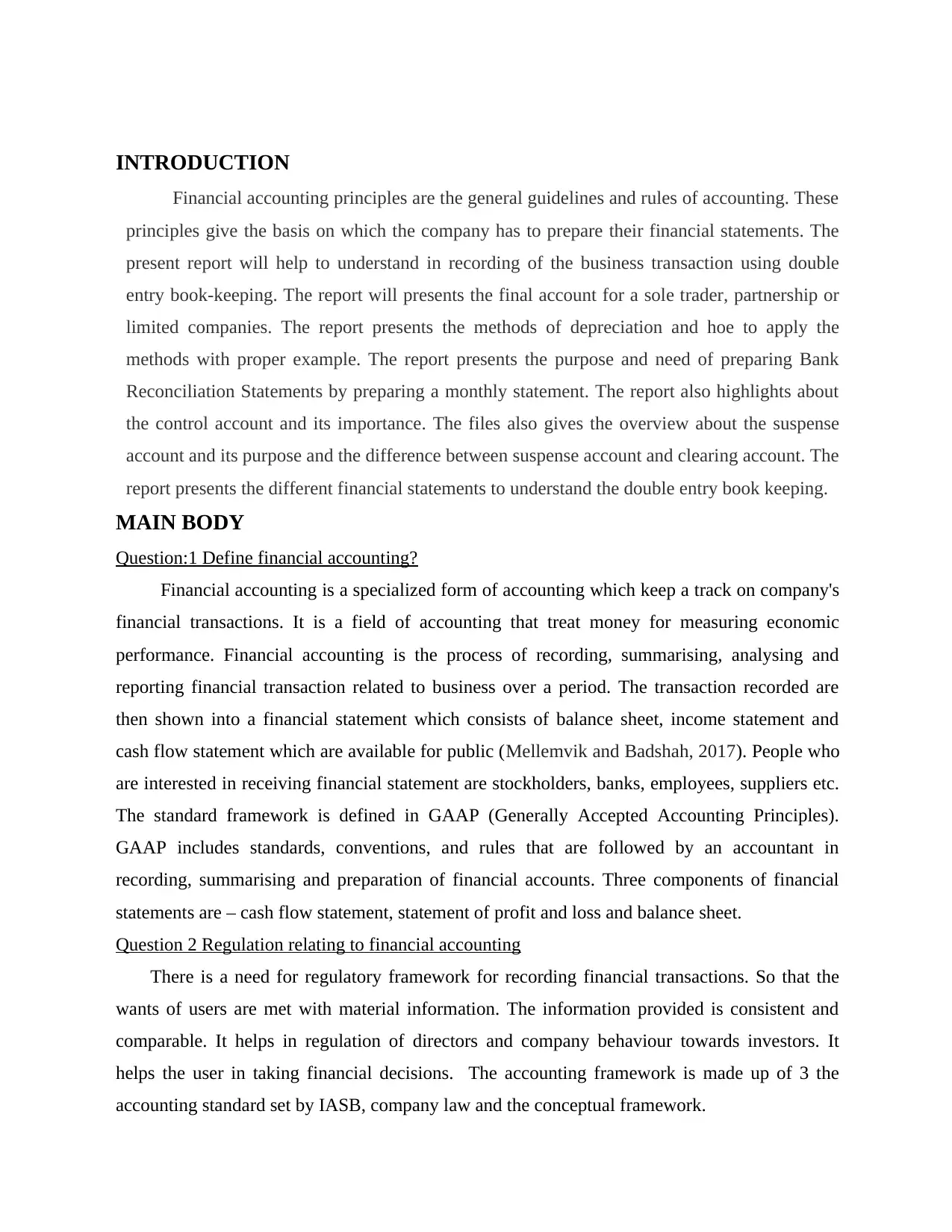
INTRODUCTION
Financial accounting principles are the general guidelines and rules of accounting. These
principles give the basis on which the company has to prepare their financial statements. The
present report will help to understand in recording of the business transaction using double
entry book-keeping. The report will presents the final account for a sole trader, partnership or
limited companies. The report presents the methods of depreciation and hoe to apply the
methods with proper example. The report presents the purpose and need of preparing Bank
Reconciliation Statements by preparing a monthly statement. The report also highlights about
the control account and its importance. The files also gives the overview about the suspense
account and its purpose and the difference between suspense account and clearing account. The
report presents the different financial statements to understand the double entry book keeping.
MAIN BODY
Question:1 Define financial accounting?
Financial accounting is a specialized form of accounting which keep a track on company's
financial transactions. It is a field of accounting that treat money for measuring economic
performance. Financial accounting is the process of recording, summarising, analysing and
reporting financial transaction related to business over a period. The transaction recorded are
then shown into a financial statement which consists of balance sheet, income statement and
cash flow statement which are available for public (Mellemvik and Badshah, 2017). People who
are interested in receiving financial statement are stockholders, banks, employees, suppliers etc.
The standard framework is defined in GAAP (Generally Accepted Accounting Principles).
GAAP includes standards, conventions, and rules that are followed by an accountant in
recording, summarising and preparation of financial accounts. Three components of financial
statements are – cash flow statement, statement of profit and loss and balance sheet.
Question 2 Regulation relating to financial accounting
There is a need for regulatory framework for recording financial transactions. So that the
wants of users are met with material information. The information provided is consistent and
comparable. It helps in regulation of directors and company behaviour towards investors. It
helps the user in taking financial decisions. The accounting framework is made up of 3 the
accounting standard set by IASB, company law and the conceptual framework.
Financial accounting principles are the general guidelines and rules of accounting. These
principles give the basis on which the company has to prepare their financial statements. The
present report will help to understand in recording of the business transaction using double
entry book-keeping. The report will presents the final account for a sole trader, partnership or
limited companies. The report presents the methods of depreciation and hoe to apply the
methods with proper example. The report presents the purpose and need of preparing Bank
Reconciliation Statements by preparing a monthly statement. The report also highlights about
the control account and its importance. The files also gives the overview about the suspense
account and its purpose and the difference between suspense account and clearing account. The
report presents the different financial statements to understand the double entry book keeping.
MAIN BODY
Question:1 Define financial accounting?
Financial accounting is a specialized form of accounting which keep a track on company's
financial transactions. It is a field of accounting that treat money for measuring economic
performance. Financial accounting is the process of recording, summarising, analysing and
reporting financial transaction related to business over a period. The transaction recorded are
then shown into a financial statement which consists of balance sheet, income statement and
cash flow statement which are available for public (Mellemvik and Badshah, 2017). People who
are interested in receiving financial statement are stockholders, banks, employees, suppliers etc.
The standard framework is defined in GAAP (Generally Accepted Accounting Principles).
GAAP includes standards, conventions, and rules that are followed by an accountant in
recording, summarising and preparation of financial accounts. Three components of financial
statements are – cash flow statement, statement of profit and loss and balance sheet.
Question 2 Regulation relating to financial accounting
There is a need for regulatory framework for recording financial transactions. So that the
wants of users are met with material information. The information provided is consistent and
comparable. It helps in regulation of directors and company behaviour towards investors. It
helps the user in taking financial decisions. The accounting framework is made up of 3 the
accounting standard set by IASB, company law and the conceptual framework.
⊘ This is a preview!⊘
Do you want full access?
Subscribe today to unlock all pages.

Trusted by 1+ million students worldwide
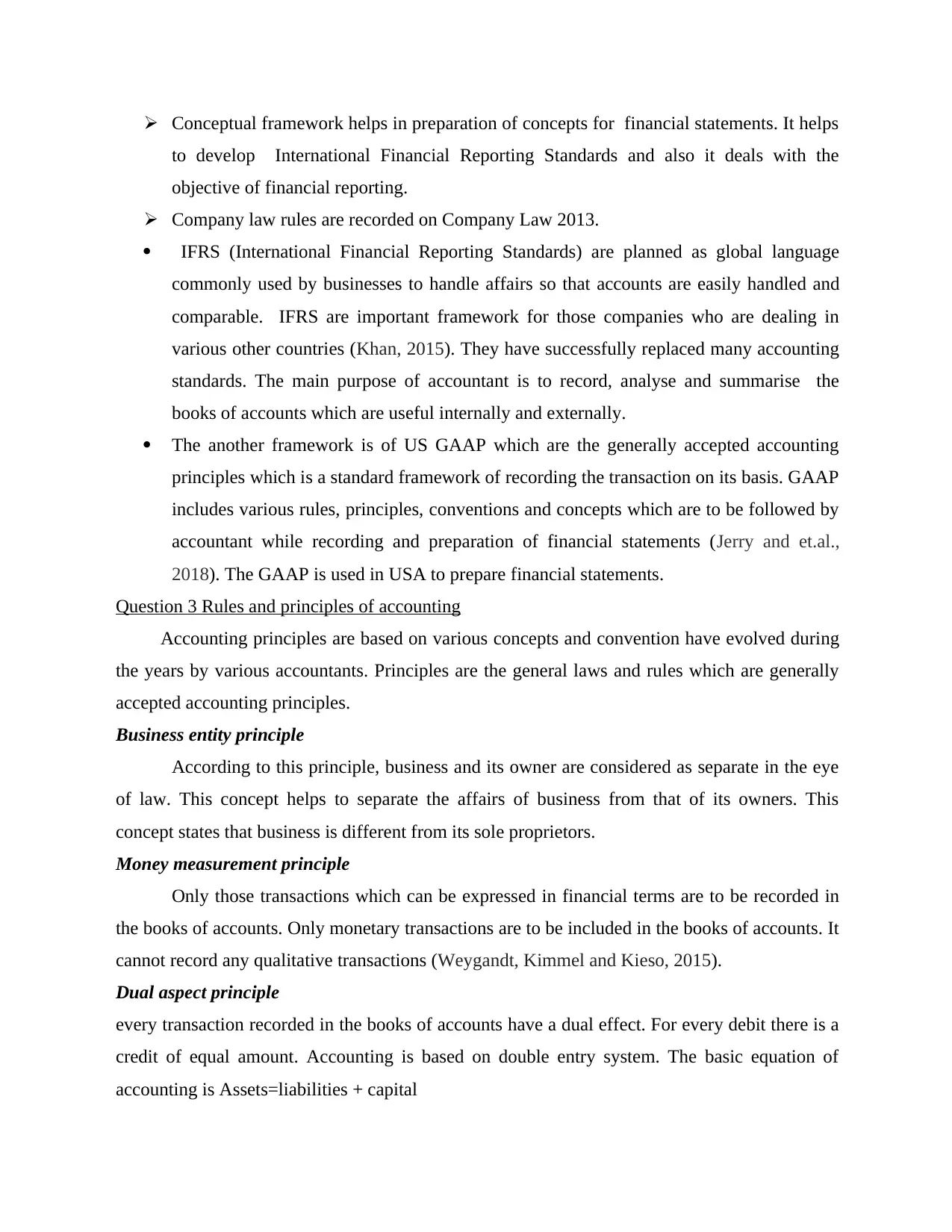
Conceptual framework helps in preparation of concepts for financial statements. It helps
to develop International Financial Reporting Standards and also it deals with the
objective of financial reporting.
Company law rules are recorded on Company Law 2013.
IFRS (International Financial Reporting Standards) are planned as global language
commonly used by businesses to handle affairs so that accounts are easily handled and
comparable. IFRS are important framework for those companies who are dealing in
various other countries (Khan, 2015). They have successfully replaced many accounting
standards. The main purpose of accountant is to record, analyse and summarise the
books of accounts which are useful internally and externally.
The another framework is of US GAAP which are the generally accepted accounting
principles which is a standard framework of recording the transaction on its basis. GAAP
includes various rules, principles, conventions and concepts which are to be followed by
accountant while recording and preparation of financial statements (Jerry and et.al.,
2018). The GAAP is used in USA to prepare financial statements.
Question 3 Rules and principles of accounting
Accounting principles are based on various concepts and convention have evolved during
the years by various accountants. Principles are the general laws and rules which are generally
accepted accounting principles.
Business entity principle
According to this principle, business and its owner are considered as separate in the eye
of law. This concept helps to separate the affairs of business from that of its owners. This
concept states that business is different from its sole proprietors.
Money measurement principle
Only those transactions which can be expressed in financial terms are to be recorded in
the books of accounts. Only monetary transactions are to be included in the books of accounts. It
cannot record any qualitative transactions (Weygandt, Kimmel and Kieso, 2015).
Dual aspect principle
every transaction recorded in the books of accounts have a dual effect. For every debit there is a
credit of equal amount. Accounting is based on double entry system. The basic equation of
accounting is Assets=liabilities + capital
to develop International Financial Reporting Standards and also it deals with the
objective of financial reporting.
Company law rules are recorded on Company Law 2013.
IFRS (International Financial Reporting Standards) are planned as global language
commonly used by businesses to handle affairs so that accounts are easily handled and
comparable. IFRS are important framework for those companies who are dealing in
various other countries (Khan, 2015). They have successfully replaced many accounting
standards. The main purpose of accountant is to record, analyse and summarise the
books of accounts which are useful internally and externally.
The another framework is of US GAAP which are the generally accepted accounting
principles which is a standard framework of recording the transaction on its basis. GAAP
includes various rules, principles, conventions and concepts which are to be followed by
accountant while recording and preparation of financial statements (Jerry and et.al.,
2018). The GAAP is used in USA to prepare financial statements.
Question 3 Rules and principles of accounting
Accounting principles are based on various concepts and convention have evolved during
the years by various accountants. Principles are the general laws and rules which are generally
accepted accounting principles.
Business entity principle
According to this principle, business and its owner are considered as separate in the eye
of law. This concept helps to separate the affairs of business from that of its owners. This
concept states that business is different from its sole proprietors.
Money measurement principle
Only those transactions which can be expressed in financial terms are to be recorded in
the books of accounts. Only monetary transactions are to be included in the books of accounts. It
cannot record any qualitative transactions (Weygandt, Kimmel and Kieso, 2015).
Dual aspect principle
every transaction recorded in the books of accounts have a dual effect. For every debit there is a
credit of equal amount. Accounting is based on double entry system. The basic equation of
accounting is Assets=liabilities + capital
Paraphrase This Document
Need a fresh take? Get an instant paraphrase of this document with our AI Paraphraser
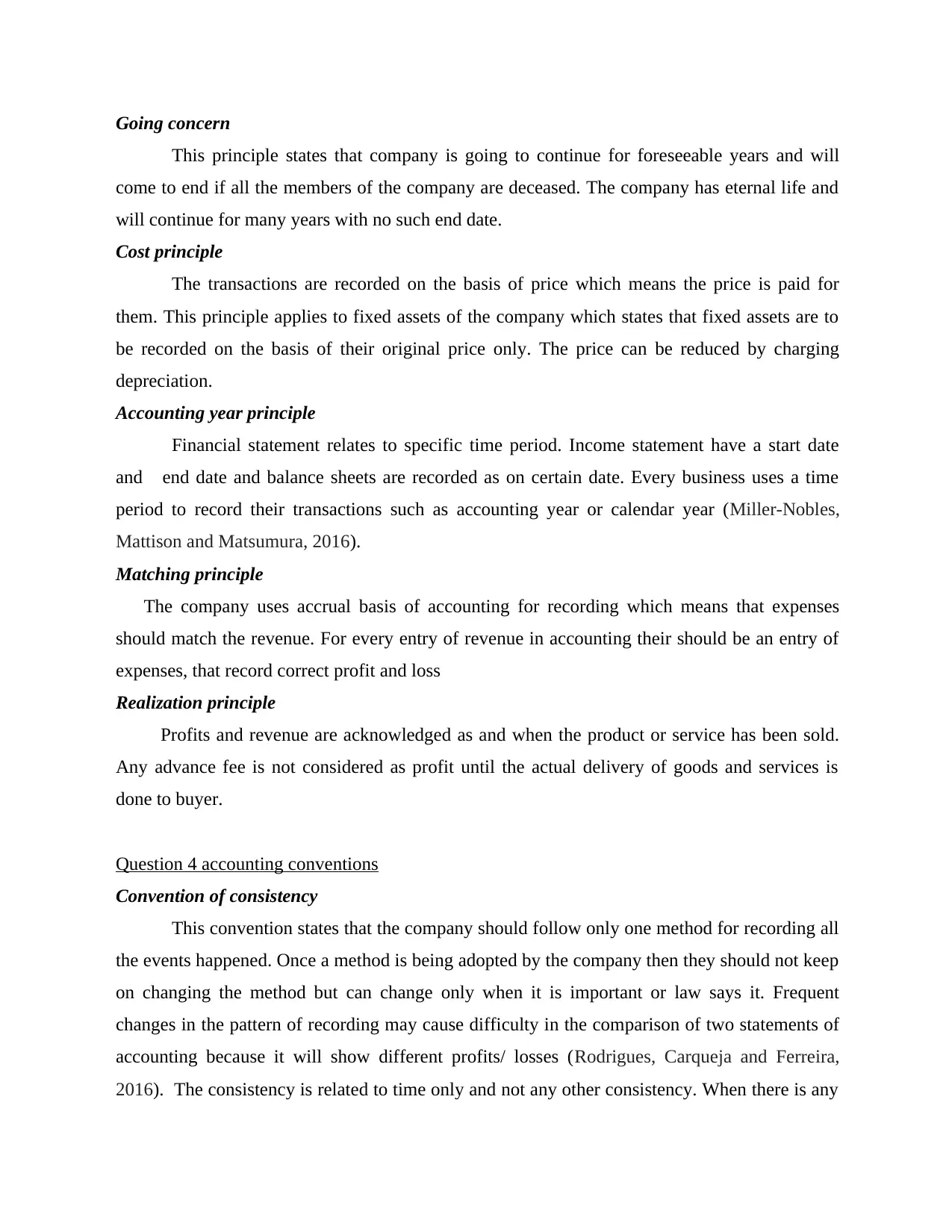
Going concern
This principle states that company is going to continue for foreseeable years and will
come to end if all the members of the company are deceased. The company has eternal life and
will continue for many years with no such end date.
Cost principle
The transactions are recorded on the basis of price which means the price is paid for
them. This principle applies to fixed assets of the company which states that fixed assets are to
be recorded on the basis of their original price only. The price can be reduced by charging
depreciation.
Accounting year principle
Financial statement relates to specific time period. Income statement have a start date
and end date and balance sheets are recorded as on certain date. Every business uses a time
period to record their transactions such as accounting year or calendar year (Miller-Nobles,
Mattison and Matsumura, 2016).
Matching principle
The company uses accrual basis of accounting for recording which means that expenses
should match the revenue. For every entry of revenue in accounting their should be an entry of
expenses, that record correct profit and loss
Realization principle
Profits and revenue are acknowledged as and when the product or service has been sold.
Any advance fee is not considered as profit until the actual delivery of goods and services is
done to buyer.
Question 4 accounting conventions
Convention of consistency
This convention states that the company should follow only one method for recording all
the events happened. Once a method is being adopted by the company then they should not keep
on changing the method but can change only when it is important or law says it. Frequent
changes in the pattern of recording may cause difficulty in the comparison of two statements of
accounting because it will show different profits/ losses (Rodrigues, Carqueja and Ferreira,
2016). The consistency is related to time only and not any other consistency. When there is any
This principle states that company is going to continue for foreseeable years and will
come to end if all the members of the company are deceased. The company has eternal life and
will continue for many years with no such end date.
Cost principle
The transactions are recorded on the basis of price which means the price is paid for
them. This principle applies to fixed assets of the company which states that fixed assets are to
be recorded on the basis of their original price only. The price can be reduced by charging
depreciation.
Accounting year principle
Financial statement relates to specific time period. Income statement have a start date
and end date and balance sheets are recorded as on certain date. Every business uses a time
period to record their transactions such as accounting year or calendar year (Miller-Nobles,
Mattison and Matsumura, 2016).
Matching principle
The company uses accrual basis of accounting for recording which means that expenses
should match the revenue. For every entry of revenue in accounting their should be an entry of
expenses, that record correct profit and loss
Realization principle
Profits and revenue are acknowledged as and when the product or service has been sold.
Any advance fee is not considered as profit until the actual delivery of goods and services is
done to buyer.
Question 4 accounting conventions
Convention of consistency
This convention states that the company should follow only one method for recording all
the events happened. Once a method is being adopted by the company then they should not keep
on changing the method but can change only when it is important or law says it. Frequent
changes in the pattern of recording may cause difficulty in the comparison of two statements of
accounting because it will show different profits/ losses (Rodrigues, Carqueja and Ferreira,
2016). The consistency is related to time only and not any other consistency. When there is any

change in the policies of accounting, then company is required to disclose all the facts and
reasons for the change in the method of recoding any event or transaction.
Convention of material disclosure
Materiality means importance. For a transaction to be recorded in a financial statement it is
required to see whether it is important to disclose or not. Firms may not record and reveal the
matters which is minute but firms must disclose every single material fact and figure which is
required to take financial decision (Ijiri, 2014). There should be materiality of accounts and
information. Even a transaction of small amount has to be recorded if it is of small amount as it
mat influence a person in decision making. They are the most important convention which helps
in decision making.
CLIENT 1
a.
reasons for the change in the method of recoding any event or transaction.
Convention of material disclosure
Materiality means importance. For a transaction to be recorded in a financial statement it is
required to see whether it is important to disclose or not. Firms may not record and reveal the
matters which is minute but firms must disclose every single material fact and figure which is
required to take financial decision (Ijiri, 2014). There should be materiality of accounts and
information. Even a transaction of small amount has to be recorded if it is of small amount as it
mat influence a person in decision making. They are the most important convention which helps
in decision making.
CLIENT 1
a.
⊘ This is a preview!⊘
Do you want full access?
Subscribe today to unlock all pages.

Trusted by 1+ million students worldwide

b.
Mentioned in appendix.
Mentioned in appendix.
Paraphrase This Document
Need a fresh take? Get an instant paraphrase of this document with our AI Paraphraser

c.
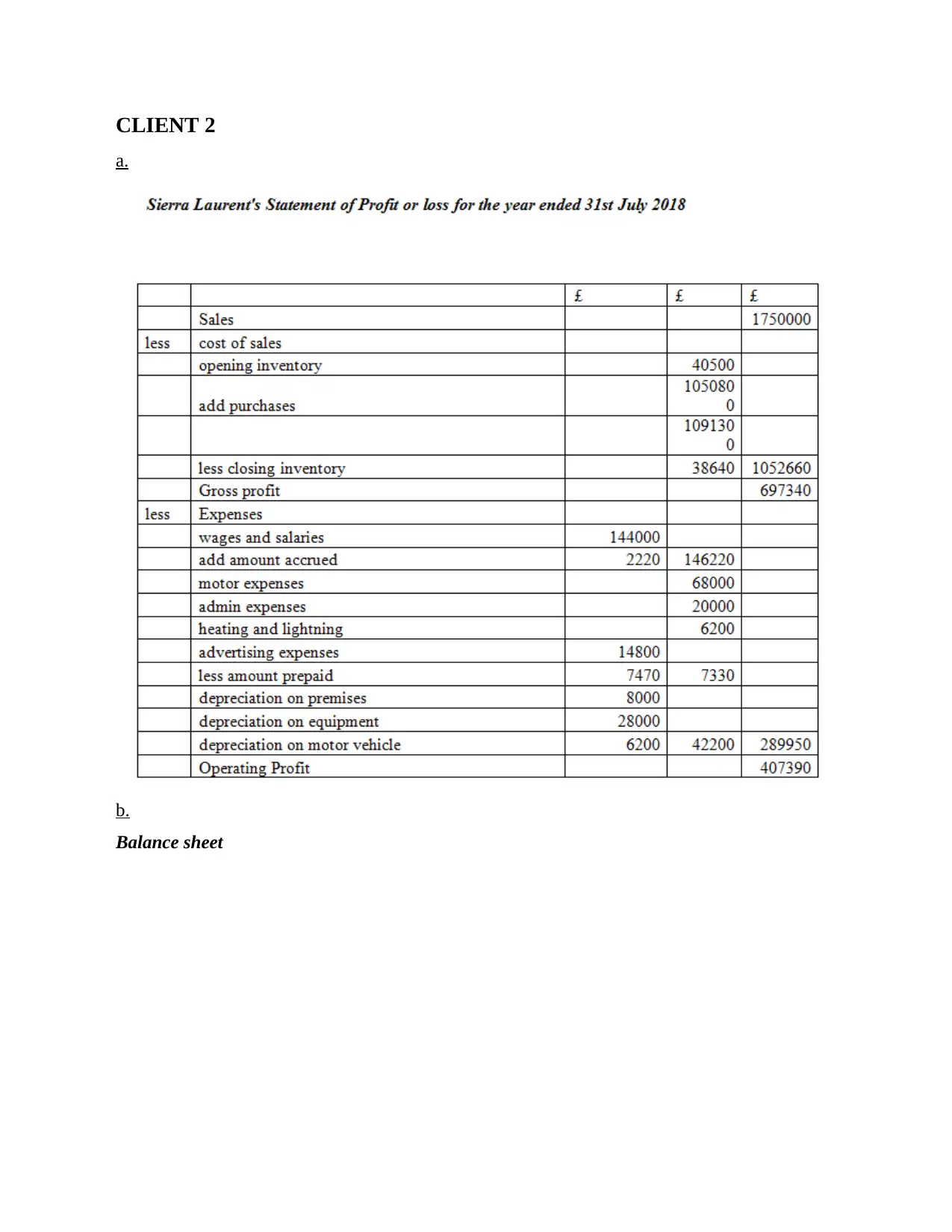
CLIENT 2
a.
b.
Balance sheet
a.
b.
Balance sheet
⊘ This is a preview!⊘
Do you want full access?
Subscribe today to unlock all pages.

Trusted by 1+ million students worldwide

Paraphrase This Document
Need a fresh take? Get an instant paraphrase of this document with our AI Paraphraser
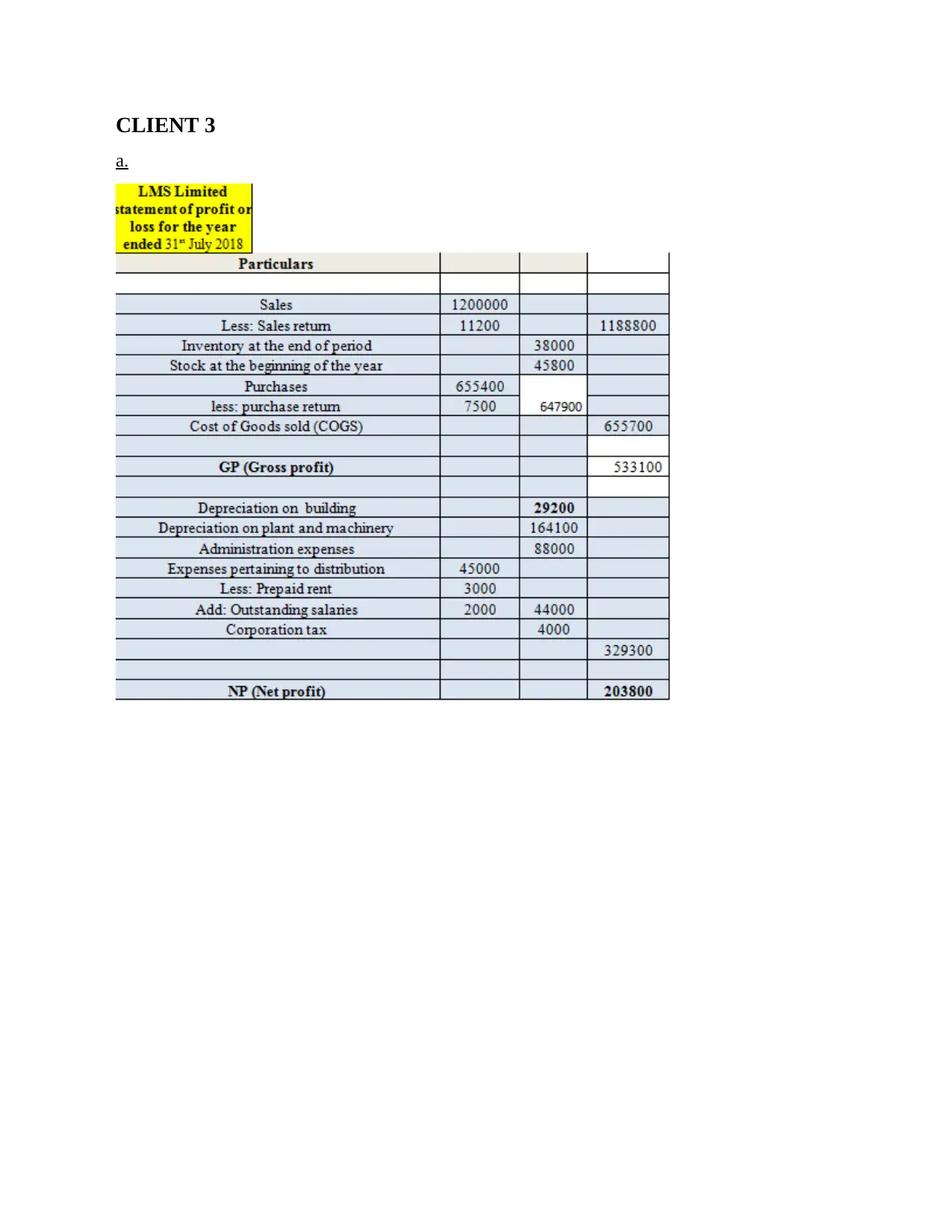
CLIENT 3
a.
a.

b.
c) The “Consistency” and “prudeuncy” concept of accounting.
Accounting concepts are the basic assumptions on the basis of which financial statements
are prepared. This are the foundation in preparing and maintaining books of records. There are
many accounting concepts made for the preparation of accounting statements. the two main
concepts of accounting are:
Consistency Concept: It stated that a company which has adopted a accounting method
should follow that method consistently in future also. Same method and technique
should be followed . It is necessary that a company must apply consistently its
accounting method and policies from one fiscal year to another. The company can
c) The “Consistency” and “prudeuncy” concept of accounting.
Accounting concepts are the basic assumptions on the basis of which financial statements
are prepared. This are the foundation in preparing and maintaining books of records. There are
many accounting concepts made for the preparation of accounting statements. the two main
concepts of accounting are:
Consistency Concept: It stated that a company which has adopted a accounting method
should follow that method consistently in future also. Same method and technique
should be followed . It is necessary that a company must apply consistently its
accounting method and policies from one fiscal year to another. The company can
⊘ This is a preview!⊘
Do you want full access?
Subscribe today to unlock all pages.

Trusted by 1+ million students worldwide
1 out of 36
Related Documents
Your All-in-One AI-Powered Toolkit for Academic Success.
+13062052269
info@desklib.com
Available 24*7 on WhatsApp / Email
![[object Object]](/_next/static/media/star-bottom.7253800d.svg)
Unlock your academic potential
Copyright © 2020–2025 A2Z Services. All Rights Reserved. Developed and managed by ZUCOL.





